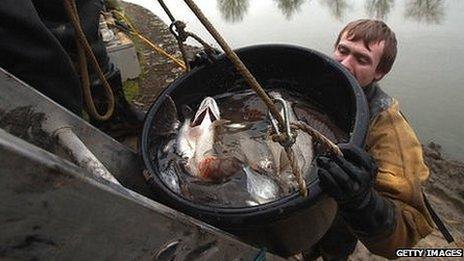Who, What, Why: How do you rescue fish?
- Published

Large parts of the UK are in drought and, as a result, fish are having to be rescued by the Environment Agency. How do you rescue fish?
It may only be March but large areas of the country are either already in drought or facing the possibility of one later this year.
Lincolnshire, Cambridgeshire, parts of Bedfordshire, Northamptonshire, west Norfolk, East Anglia and the South East have been given official drought status by the Environment Agency (EA).
A drought being declared involves a combination of factors, including lowgroundwater levels and river flows. The lack of water in many rivers means the agency has begun rescuingfishand transporting them to safety. So how do they do it?
Electric probes are used by fisheries officers to stun the fish so they can be moved, says a spokeswoman for the EA. The probes send a very mild electric charge through the water and stun the fish for about 10 seconds.
They are then gathered in nets and moved to oxygenated tanks. If possible, they are moved to another part of the river where there is still enough water for them to survive. If that isn't possible they are moved elsewhere.
The method is used because capture rates can bemuch higher than other methods, externalsuch as netting. Hundreds of fish can be caught at one time. It is carried out from a boat or by someone wearing protective waders in shallow waters.
Fish have already been rescued from rivers across the Midlands and southern England, say the agency spokeswoman.
"We started having to do a few rescues in November and December last year, which is almost unheard of. We are expecting to do a lot more over the next few months and over the summer."
Only approved operators can use the equipment, which is described as very "fish-friendly". There are few mortalities, says David Rogers, professor of freshwater biology at the University of Derby.
"The fish recover quite quickly. It's like us going in for an operation and being anaesthetised and coming round afterwards, you feel a bit groggy."
Another method used is called "seine netting". This is when a net is hung vertically in the water, the bottom held down by weights and the top buoyed by floats. Fish are caught in the netting, which is drawn like a curtain across a sectioned-off area of a river or pond.
"Either method can catch masses of fish," says Rogers.
Where river levels are extremely low, looking more like a series of ponds, the remaining water can be pumped out and the fish collected. Methods are also used to get more oxygen into rivers before the agency resorts to rescuing fish, these include aeration devices and putting hydrogen peroxide in the water.
Rivers are monitored by agency staff and members of the public also report problems, such as seeing fish gasping for air.
Where to put rescued fish can often be a problem, says Rogers. Moving them to another section of the river could mean that area becomes over dense and there is not enough food to go around.
In some cases, the size of the fish population is regulated.